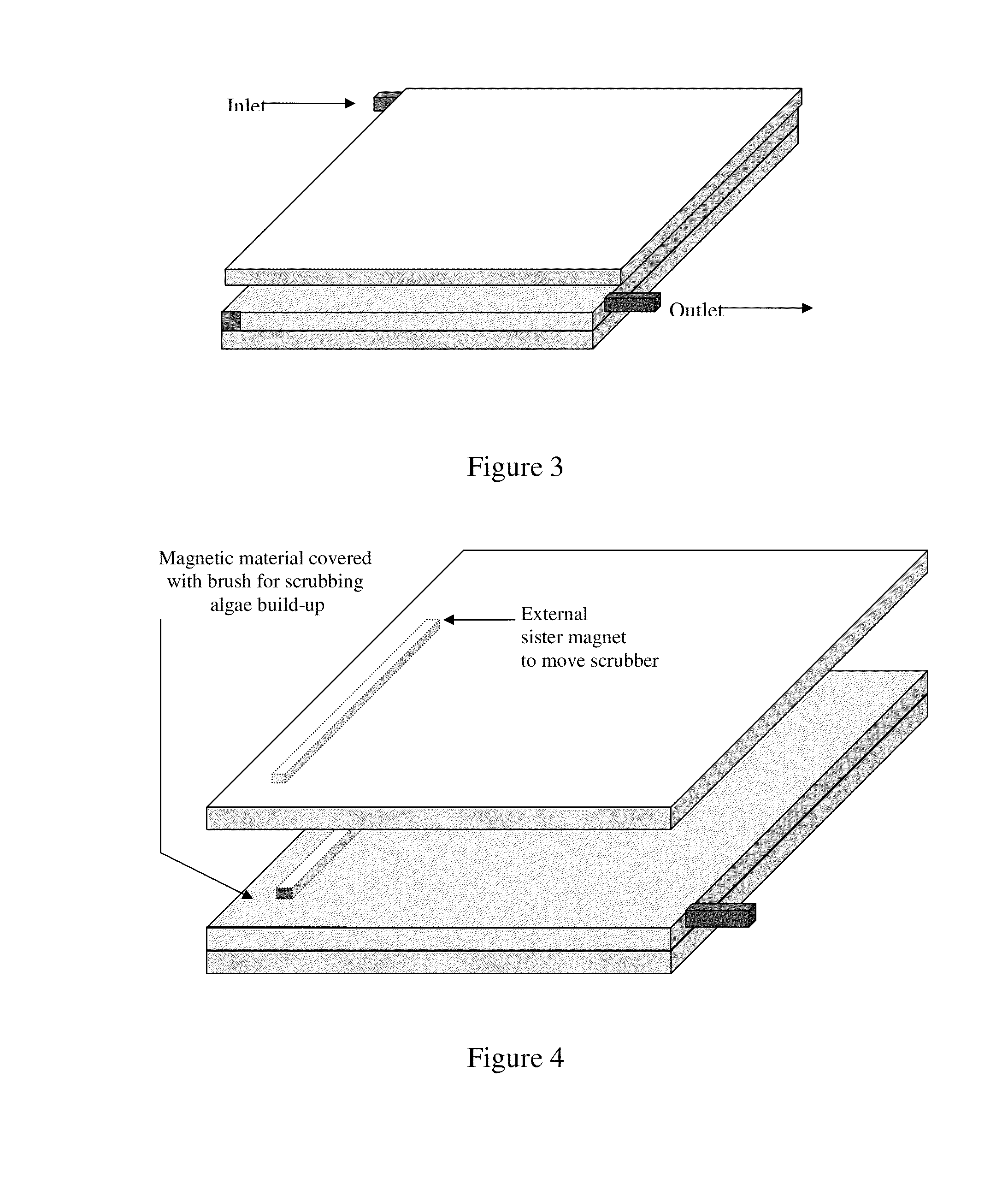Systems and methods for production of algal biomass
a technology of algal biomass and production methods, applied in the field of systems, can solve the problems of unpredictable and intermittent electricity generation, environmental damage, and energy costs, and achieve the effects of improving the quality of algal biomass
- Summary
- Abstract
- Description
- Claims
- Application Information
AI Technical Summary
Benefits of technology
Problems solved by technology
Method used
Image
Examples
example i
Implementation of Biofuel Generator System at a Distillery
[0171]The panel system was tested at a Scottish distillery. Panels were placed on a horizontal frame adjacent to an effluent tank as shown in FIG. 30. The distillery tests revealed several unexpected discoveries.
[0172]One of the tests panels was using effluent from the malting and distilling process. This effluent is high in nitrates, phosphates, copper, and copper ions. Currently the distillery pays farmers to collect and dispose of the effluent on their fields. However, recent proposed changes to the national legislation will disallow the disposal of effluent in this manner.
[0173]The test comprised the following three experiments to test the effect of flue gas: 1) directing flue gas from the effluent tank gas into a panel (35&36) comprising algae (Chlorella vulgaris); 2) control algae, no flue gas (37); and 3) an empty panel (38) into which flue gas was directed. In parallel, as illustrated in FIG. 31, effluent from...
example ii
Laboratory Testing of Algae Grown with Effluent
[0186]In these experiment, two batches of effluent were tested for effects upon algae growth in Test panels. The results are shown in Table 2.
TABLE 2Batch 1Batch 1PostFoodNetElementSample 1Sample 2AverageDilutionBatch 2addedChangeNotesNa ppmSSSNa44.66963400UnknownppmMg34.4266.8450.635.06Mg9.23956300−304.18ppmppmP ppm186.49322.81254.6525.4P ppm9.926043160−144.53S ppm25.3155.4340.374.03S ppm6.2103932.18(from flue gas)K ppm202.05354.96278.527.8K ppm21.684400−393.88Zn ppb162.01286.39224.222.4Zn ppb31.920319.52(from mineralwater)Ca ppm8.7510.339.540.95Ca34.7740233.82(from mineralppmwater)Mn143.34429.7286.5228.6Mn61.04165200−232.44ppmppmFe ppb790.72668.86729.7972.9Fe ppb51.32773300−278.43Cu ppm1.330.440.8850.089Cu0.01902−0.07ppmNi ppm0.0060.0080.0070.00100Ni0.0116960.01(from flue gas)ppmCl ppmNotN / AN / ACl39.31347Unknown(from mineralTestedppmwater)
[0187]1 litre of Batch 1 and 1 litre of Batch 2 of the effluent were mixed. Batch 1 is from the in...
PUM
| Property | Measurement | Unit |
|---|---|---|
| mass | aaaaa | aaaaa |
| mass | aaaaa | aaaaa |
| w/w | aaaaa | aaaaa |
Abstract
Description
Claims
Application Information
 Login to View More
Login to View More - R&D
- Intellectual Property
- Life Sciences
- Materials
- Tech Scout
- Unparalleled Data Quality
- Higher Quality Content
- 60% Fewer Hallucinations
Browse by: Latest US Patents, China's latest patents, Technical Efficacy Thesaurus, Application Domain, Technology Topic, Popular Technical Reports.
© 2025 PatSnap. All rights reserved.Legal|Privacy policy|Modern Slavery Act Transparency Statement|Sitemap|About US| Contact US: help@patsnap.com



